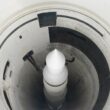Ignored in the blitzes of both Gaza and Lebanon is the fact that the Israeli Defense Force (IDF) has fired hundreds of thousands of munitions supplied by the US that are typically made with depleted uranium (DU). Also disregarded is the fact that while the IDF targets Gaza, the uranium oxide dust which falls from the blasts is nomadic. This means it can float hundreds of miles to Israel, Jordan, Egypt and even farther. Thus, those who survive the bombs and others in the Mid-East will inherit a toxic wasteland: the air they breathe, the food they eat and the water they drink will be laced with the ash for years.
These blasts create intense heat and plumes of smoke that soar 1,000 to 2,000 feet in the air and carry the ash for miles. Dai Williams, a British weapons researcher, says that “when the U.S. bombed Baghdad in 2003, uranium dust was found 2,500 miles away in the U.K. Atomic Weapons Establishment’s air sampling filters about 10 days later.”
Journalists and concerned scientists who have tried to establish the wider public health hazards posed by the use of DU-equipped munitions have been consistently stonewalled by military and industry officials. Moreover, both US and Israeli authorities have refused to acknowledge that the munitions deployed by Israel in its attacks on Gaza and Lebanon contain depleted uranium.
As recently as 2023, Pentagon spokesman Marine Corps Lt. Col. Garron Garn assured PBS that DU munitions are “conventional,” which means non-nuclear. Back in 2012, John Kirby, President Biden’s national security advisor, who was a rear admiral in the U.S. Navy and its chief spokesperson, peddled a similar narrative: “Health studies have been done on depleted uranium munitions and it is not a radioactive threat.”
But conventional they are not. In 2012, the United Nations International Agency for Research on Cancer (IARC) labeled uranium a “Class 1 human carcinogen” and noted that DU shells produce both “radiation and heavy metal (chemical) hazards.”
The uranium munitions names are an alphabet soup of letters and numbers that are mostly meaningless to the non-military public. And the labels are frequently fanciful—such as SPICE bombs, Apache gunships, Warthog jets that fire Avenger guns, and BLU 109 bombs (nick-named bunker-busters)—which disguise their deadliness. But whether the bombs are smart (guided) or dumb (non-guided), 2,000 pounds or fewer, they are fitted with warheads made with DU penetrator rounds.
The U.S. has said little about the munitions it has sent to Israel since the October 7 Hamas attack. But the November 16, 2023 Haaretz Daily Newspaper reported that since the war started, Israel has asked for and received tens of thousands of 30mm, 120mm mortars and 155mm shells for its helicopters and tanks. Haaretz’s source was the U.S. Air Force.
Although the U.S. doesn’t broadcast that the shells are made with depleted uranium, the Museum of Radiation and Radioactivity in Oak Ridge, Tennessee, stated that “30mm and 120mm shells use DU penetrators.”
When this reporter asked the DOD if the U.S. sent these munitions to Israel, Pentagon spokesman Lt. Col. Bryon McGarry answered, “we don’t comment on specific cases.” Also, a former U.S. official said they can be produced without DU and noted that though the U.S. sent 155mm DU rounds to Ukraine, as the BBC reported on September 7, 2023, DU penetrators aren’t needed in Israel because “unlike Ukraine, this is not a tank war.”
Others disagree. Researchers who’ve studied the weapons since the 1990s say the only munitions that can collapse the tall buildings in Gaza which sit atop Hamas tunnels are those made with DU penetrator tips.
Why DU Is Dangerous
Depleted uranium is a waste product of the process to enrich uranium for nuclear weapons and nuclear reactor fuel. Dr. Keith Baverstock, a radiation and public health advisor to the World Health Organization (WHO) from 1991 to 2003, said that “when DU shells explode, they create colossal grayish-black clouds of uranium oxide dust that stick to everything.
“People breathe the dust, which lodges in their lungs. From there it seeps into their blood and lymph systems, flows throughout their bodies and binds to genes, causing them to mutate. Within just a few years, the dust can trigger birth defects and in five or more years, lymphoma and leukemia, especially in children. Organs, such as the kidneys, fail, due to the uranium particles that penetrate there. Other cancers develop later.”
According to Dr. Asaf Durakovic, a U.S. Army colonel and chief of Nuclear Medicine at Walter Reed Army Medical Hospital and the Veterans’ Hospital in Wilmington, Delaware in the 1990s, “people who are exposed can be very ill even after just a few weeks’ exposure.” Dr. Durakovic, who studied DU’s health effects on Gulf War U.S. veterans, said, “three members of my research team went to southern Iraq to collect soil and water samples from the heavily bombed areas. Two who were exposed to the uranium ash soon became seriously ill. One, a Canadian who was there for only six days, had fever, lung and urination problems and blood in his urine.”
A Noxious Mix
Scientists who tested the soil, water and rubble in countries where uranium munitions were used since the early 1990s—such as Iraq, Afghanistan, Kosovo, Lebanon and Gaza—reported that the samples revealed even more deadly elements than DU. The analyst Dai Williams says that in Gaza, “55 samples of the concrete rubble from Israel’s 2006 bombing contained traces of undepleted and slightly enriched uranium. Even plutonium, the deadliest of all elements.” To make matters worse, “the concrete rubble in Gaza was crushed after the earlier bombings and was used to construct new buildings, which means the uranium is locked in.”
In 2001, the UN Environmental Program’s Depleted Uranium Assessment Team and the International Atomic Energy Agency (IAEA) reported that the Swiss Laboratory Spiez, the Swedish Radiation Protection Program Institute and three other European laboratories “analyzed 340 water and soil samples collected from Kosovo in November 2000 and found traces of plutonium in the DU projectiles.”
The Human Toll: Kosovo, Iraq, Gaza, Afghanistan and U.S. veterans
Kosovo. Although the 1999 NATO bombing in Kosovo lasted just three months, the fallout was intense. Dr. Ilir Kurtishaj, an oncologist at the University Center Oncology Clinic in Pristina reported in 2022 that the hospital treated 1,850 cancer cases that year—among them, breast, lung and colon cancers were the most common. He added that “by 2023, the 1,850 cases could increase by another 10 to 15 percent, as they have year after year.”
Dzafer Buzoli, a Kosovan who worked with the UNHCR (the UN refugee agency) told me that his extended family lived within eight kilometers (five miles) from Shtime, the town NATO bombed from March to June. “Fifty-nine members of my family have had cancers, 47 of whom have died. One was my 52-year-old mother, who had breast cancer. Two were children—five and 12 years old—who had brain cancers. And my wife has had two surgeries to remove breast tumors.
“But as early as 2001, people were getting sick. Many had breathing problems that are now much worse, so bad that they need inhalators to breathe. I’ve raised funds to buy 720 and this past summer I raised money to buy another 300 of them.”
Buzoli adds that he’s been “de-contaminating the bomb sites. I dig up the soil, replace it with clean dirt and plant grass seed on top. I did this four times and each time I was very sick right afterwards. I had a hard time breathing, was exhausted, and sweating like crazy. Now, my left lung has just 60 percent capacity.” Two months ago, Buzoli moved his family to Serbia, which wasn’t bombed. “I have to protect my two daughters.”
Buzoli also pointed out that “the oncology doctor in Pristina who reported on the cancers didn’t link them to uranium weapons because people here see NATO as the force that helped Kosovo win independence from Serbia.”
Iraq. Dr. Amy Hagopian, a University of Washington School of Public Health professor, found that “birth defects in Basra surged from 37 cases in 1990 (one year before the Gulf War) to 254 cases in 2001.” Also, within one or two years of either parent being exposed, babies were born missing eyes, hands and legs. Or stomachs and brains inside out.
And in a joint study by Washington and Basra Universities, Hagopian and other researchers wrote in a 2010 American Journal of Public Health article that “since the Gulf War, the number of children suffering from leukemia surged from 15 in 1993 to 97 in 2006.” When Hagopian compared Iraq’s leukemia rates to those in neighboring Kuwait and Oman, as well as in the U.S. and European Union, they “compared unfavorably.” Dr. Chris Busby, a British physical chemist explained that “leukemia develops more quickly than other cancers because “blood cells are the most easily damaged by radiation. We’ve known this since Hiroshima.”
U.S. and U.K veterans. Dr. Durakovic wrote in a 2016 Environmental Health and Preventive Medicine article that “75 percent of U.S. Gulf War veterans still had uranium in their urine long after the war ended, which proved they were exposed to radiation. Also, British veterans who served with NATO in Kosovo had uranium in their urine.” Further, he said that “troops and populations exposed to uranium dust had a higher incidence of lung and breast cancers, lymphoma and kidney disease.” Dr. Durakovic, who died in 2020, said the veterans’ illnesses mirrored those of Iraqi civilians.
Further, Boston University School of Public Health associate professor Kimberly Sullivan, the lead researcher in a study of U.S. Gulf War veterans, reported in a November 2021 Brain Sciences article that they suffered “long-term debilitating pain in their muscles and bones, shortness of breath, severe headaches, fatigue, memory problems, skin rashes, ulcers, sore throats, night sweats, chest, stomach pain and diarrhea.” The study said the possible causes were “exposure to chemicals such as nerve gas, smoke from oil wells and DU.”
Although the Pentagon and U.K. Ministry of Defense still deny that any military have been sickened from their exposure to these munitions, a 2020 Environmental Research article noted that “kidney problems have been observed in a recent study of Gulf War veterans exposed to DU. This gives some support for the suspicion that DU may represent one of the causes for the so-called Persian Gulf syndrome….resulting from the conflict of 1991 when some 300 tons of these munitions were fired from aircraft cannons and tanks by U.K. and U.S. forces.”
Gaza. Israel used DU munitions in Gaza from 2006 until the present, and bombed it in 2008, 2014 and 2021. Dr. Paola Manduca, a University of Genoa geneticist and eight other researchers—including a Norwegian physician, Dr. Mads Gilbert, who treated Gazans for a decade but is now banned from entering the area—reported in the 2021 International Journal of Environmental Research and Public Health that there was “a major increase in birth defects and pre-term births from 2011 until 2016.” They also found “negative birth outcomes from 2016 to 2019 among mothers exposed to the 2014 bombings and/or to hot spots of heavy metals such as barium, arsenic, cobalt, cadmium, chrome, vanadium and uranium.”
Israel. Since DU dust doesn’t respect national borders, the toxic ash may have increased the incidence of cancer in Israel and Lebanon. According to a 2015 report in the Israeli journal, Molecular Medicine, three Israeli researchers said that their country has “the highest incidence of non-Hodgkin’s lymphoma cases in the world.” Dr. Ora Paltiel, a hematologist/epidemiologist at Jerusalem’s Hadassah Hospital, explained this is because “Jews have a genetic predisposition to lymphoma.” She also wrote that the lymphomas may be linked to pesticides, since “many Israelis live near farms.” The report doesn’t mention exposure to the DU dust which could have floated to Israel from Gaza and Lebanon.
Lebanon. Interestingly, Israel’s Molecular Medicine report also states that Lebanon, which is at Israel’s northern border, is the country with the next highest lymphoma rate. However, Dr. Paltiel’s observation about the genetic predisposition of Jews could not be a factor in Lebanon, since, according to a December 2020 Times of Israel article, only 29 Jews still lived in Lebanon that year.
Thus, it is possible that the lymphomas could be fallout from Israel’s bombing of south Beirut and the town of Khiam in 2006, when it used the same munitions as in the current war. Williams, the British researcher, took soil, dust and water samples from the bottom of a bomb-created crater in Khiam and laboratory tests showed medium and high levels of undepleted uranium—many times higher than in the samples he took from the crater’s rim.
The Pentagon’s Preference
The Pentagon prizes DU shells because they’re denser than those made with other heavy metals. This means they can pierce through enemy tanks and bunkers in a stroke (as in Iraq) and caves (in Afghanistan). Once inside their targets, the shells explode into firestorms that produce uranium particles.
Although Hamas has no tanks, the IDF prizes the DU munitions it fires in Gaza. Dr. Patrick Bury, a senior lecturer at Bath University, told Al Jazeera that “the bomb can enter the top of a structure and penetrate all the way to the foundation, collapsing the entire building.”
A researcher (who asked for anonymity) who tested soil, water and urine samples from Afghan and Iraqi civilians told me, “since the munitions hit targets at one mile a second, you’d think their front ends would mushroom. But because they’re made with uranium, they actually sharpen. They have to have uranium warheads if they’re going to penetrate through layers of concrete. The DOD publicly says the shells use tungsten penetrators to distract from the truth. But tungsten is much too expensive and relatively rare, compared to uranium.”
A 1999 U.S. Army training film lists other plusses. It tells recruits that “DU is extremely cheap because it’s a waste product of the atomic energy industry. The arms industry can even get it for free.” Also, it says that “DU is superior to alternative metals for its superior range and killing power…and it can smash through all known armor.”
DOD’s Decades of Denials
For U.S. veterans concerned about the hazards, a DOD site offers reassurances: “Fortunately, DU is only mildly radioactive.” It acknowledges that “gamma rays are a form of highly-penetrating energy,” but adds that “the amount emitted by DU is very low.”
The site says the risk of chemical hazards “is minimal” because there is “little likelihood that sufficient quantities of DU could be inhaled or ingested to cause a heavy metal concern.”
It offered still more assurances to veterans on a December 2000 question-and-answer online site. “Question: Can exposure to DU be the cause of leukemia?” Answer: “It is highly unlikely.” Question: Were DU health effect studies conducted after the Gulf War? Answer: “The Army’s latest estimates…show that these exposures were well within safety standards.” It adds, “individuals with elevated levels of uranium in their urine 10 years after the Gulf War have not developed kidney abnormalities, leukemia, bone or lung cancer, or any other uranium-related adverse outcome” (italics added).
The U.S. Veterans Administration (VA) echoes the DOD almost verbatim. Having studied Gulf War veterans who inhaled “significant quantities of DU” and “had uranium in their urine 10 years later,” the VA stated that “none of the individuals with DU fragments their bodies and uranium in their urine have developed kidney problems, leukemia, bone or lung cancers or any other uranium-related outcomes.” Also, “no birth defects have been reported in their children.”
Even as recently as June 2023, a DOD spokesperson told the Wall Street Journal that “the Administration was considering a shipment of DU munitions to Ukraine,” and again repeated its no-danger refrain: “DU munitions are common…and DU residues in the environment do not pose a radiological hazard to the population.”
Why such denials? Dr. Durakovic’s answer was clear-cut. “There are two reasons and both involve money. The cost to compensate the sick and clean up the battlefields would be exorbitant.”
DOD and VA Knew Well
In fact, the DOD and VA are well aware of the dangers. When the first Gulf War ended, the U.S. had to dispose of the 4,000 Iraqi tanks and armored vehicles it destroyed with uranium munitions. Calling the tanks a “substantial risk,” U.S. troops were told to bury them in Saudi Arabia’s desert. Also, according to a 2003 Christian Science Monitor article, 16 of the vehicles were brought back to South Carolina, of which “six had to be buried in a low-level radioactive waste dump.”
The U.S Army was very much in the loop: its 1999 film for recruits described the DU dangers and how to avoid them: “Minimize your exposure time, maximize your distance from the DU ash, and use protective clothing, such as masks and gloves, because DU ash may be picked up and ingested.”
The film also instructed recruits to “wash off the dust before eating, drinking or using the latrine.” Why? “Depending how much DU is inhaled, swallowed or gets under the skin, heavy metal poisoning may occur which can damage internal organs and tissues.” Further, it stated that “a possible long-term hazard from DU dust is contamination of the ground and water supply.” But “fortunately, DU is only mildly radioactive. The bottom line if you’re involved in a detonation or fire with DU is that uranium hazards are relatively small.”
Other countries knew, too. Before the U.S. launched Operation Iraqi Freedom in 2003, a New York Times article said, “the cancer deaths of 24 European soldiers and illnesses of many others who served in the Balkans in the 1990s stirred alarm about the DU munitions fired from American warplanes in Bosnia and Kosovo.” It also noted that the link between DU and the illnesses “hasn’t been proved, and “many scientists think it’s impossible.” But it added that “some scientists are re-examining the work of Dr. Asaf Durakovic who said, “the illnesses in Gulf War vets may be linked to the uranium he found in their bodies.”
Also, in December 1999, a U.S. Environmental Protection Agency (EPA) report said, “DU is toxic and considered by the EPA to be a radiation health hazard when inside the body.”
According to Scott Peterson, a Christian Science Monitor reporter in Baghdad in 2003, “the Pentagon was so aware of the hazards that U.S. military guidelines developed after the first Gulf War…required any soldier coming within 50 yards of a tank struck with DU to wear a gas mask and full protective suit.” Peterson also noted that he carried a Geiger counter which “started singing when it neared a DU bullet fragment no bigger than a pencil eraser…registering nearly 1,000 times normal background radiation levels.”
Rarely have U.S. agencies admitted the dangers. One exception is a VA August 2021 report, which stated that Gulf War veterans “may be at increased risk for amyotrophic lateral sclerosis (Lou Gehrig’s Disease), multiple sclerosis, Parkinson’s disease, or brain cancer.” These risks “may be related to potentially hazardous environmental exposures during the war, such as oil well fire smoke, chemical and biological warfare agents, multiple vaccinations, depleted uranium, pesticides, and endemic infectious diseases (italics added).”
Unusual Secrecy
Unlike the Pentagon’s updates about the weapons the U.S. sends Ukraine, the department has been mostly silent on those sent to Israel. Some deliveries even bypassed Congress under “emergency” orders.
According to a May 8, 2024 New York Times article, “lawmakers and news media have recently criticized the lack of public information about the sales. The Department of Defense so far has only published two news releases, on December 9 and 29, about the approval of emergency military sales to Israel.”
William Hartung, an expert on weapons sales at the Quincy Institute for Responsible Statecraft, told The Intercept in November 2023 that “the purposeful lack of transparency over what weapons the U.S. is supplying to Israel is tied to the larger Administration policy of downplaying the extent to which Israel will use those weapons to commit war crimes and kill civilians in Gaza.”
Scientists Hounded
Researchers such as Dr. Durakovic and Dr. Baverstock, who questioned the official line, have fared poorly: in 1997, the head of Delaware’s VA Hospital warned Dr. Durakovic to stop his research. When he refused, he was fired. “I was hounded for trying to break through an international conspiracy of silence about DU’s deadly legacy,” he said. “My house was ransacked and my family was threatened with anonymous telephone calls.” To continue his research, he founded the Uranium Medical Research Center (UMRC) in Toronto.
Dr. Baverstock was also targeted. “In 2001, I was on a WHO committee that prepared a monograph about DU weapons. I warned about their toxic effect on DNA, but my comments were rejected.”
When the BBC asked Dr. Baverstock in a 2006 interview why his work was suppressed, he said, “It’s naive to think that institutions like the UN are free from political influences.” When the reporter asked if the U.S. pressured the WHO, he answered, “Yes. I think that could be the case.”
However, Dr. Baverstock told me he was among a group of researchers who wrote a second WHO monograph in 2012 on the effects of DU weapons. “When I insisted uranium should be classified as a carcinogen, this time the WHO did the right thing and included my comments.”
Laboratories also fare badly. Those that test soil, water and urine samples, find radioactive remains and publish their results, may lose their funding or are closed. This happened to a lab used by the UMRC (Durakovic’s research center)—such as the Radiogenic Isotope Laboratory at Memorial University in St. Johns, Newfoundland. Dai Williams notes that two other Canadian labs testing veterans’ urine were told to stop. Also, labs at the Goethe University in Frankfurt and the University of Wales were shut.
Disability Benefits Denied
Veterans with disabling medical conditions that may be linked to uranium exposure have a hard time proving why they can’t work and need financial aid. Although the VA finally admitted in 2023 that some U.S. veterans may have been exposed to hazardous substances, it says they must convince authorities on a case-by-case basis. Most often, their claims are denied.
Worse, according to a 2019 EPA report, “no technologies exist that are capable of significantly reducing the chemical and radiological toxicity of DU.” Dr. Robert Miller, a Vanderbilt University lung specialist who examined over 200 Gulf War veterans noted that “many doctors, even in the VA, don’t have the resources or understanding of the illnesses to treat them.”
The anonymous uranium expert says, “the bombs and shells contain other heavy metals such as aluminum, iron, mercury, arsenic and cadmium, which also have long-term carcinogenic effects on the kidneys, liver, bones and brain, and cause heavy metal poisoning. The U.S. fired them in the Afghan countryside—which is sparsely populated. But the IDF is using them in densely packed urban areas, which is nuts. The death and destruction is massive.”
According to Bath University’s Dr. Patrick Bury, “Israel has these munitions and is using them. I don’t think they really care that much about collateral damage.”
Thus, as with Agent Orange, the defoliant the U.S. sprayed throughout Vietnam which left a toxic legacy, the Gazans, Lebanese, Israelis and their neighbors in the Mid-East will endure the uranium poisons for generations.
Barbara Koeppel is a Washington, D.C.-based investigative reporter who covers social, economic, political, and foreign policy issues.






0 Comments